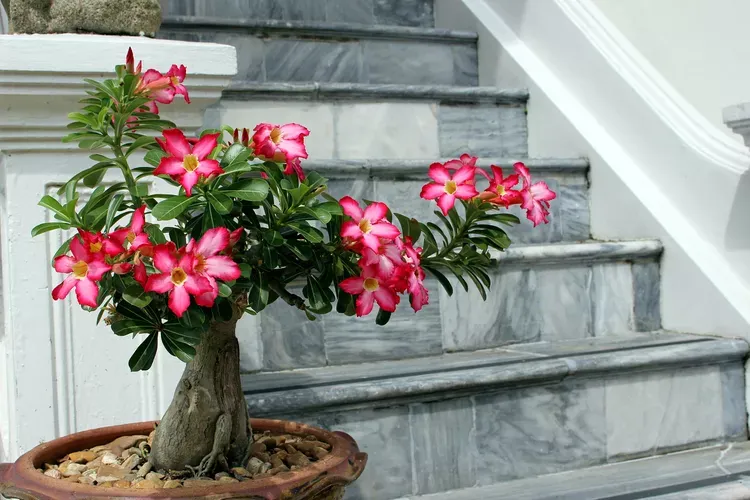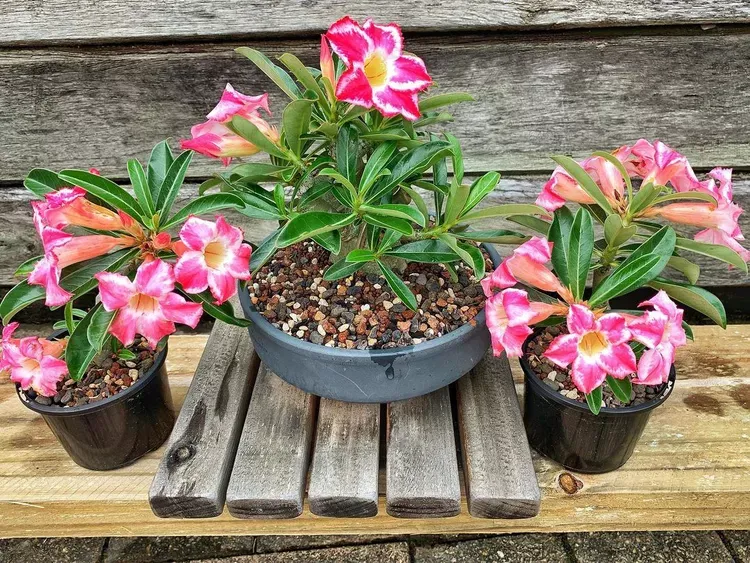- No products in the cart.
The desert rose bonsai, known botanically as Adenium obesum, stands out as an exceptionally easy-to-care-for house plant. It thrives in various trained shapes and reemerges each spring, shedding its winter leaves to showcase vibrant flowers in shades of red, pink, and deep purple on its stout trunk. As a succulent tree, it can flourish in a container or as a bonsai, growing slowly at about 12 inches per year. Due to its toxicity to humans and pets, it’s crucial to position the desert rose in areas inaccessible to children, cats, and dogs.
Botanical Name: Adenium obesum
Common Names: Desert rose, Sabi Star, desert azalea, Japanese frangipani
Plant Type: Succulent tree
Mature Size: Up to 9 feet tall and 4 feet wide outdoors; 2 feet tall indoors
Sun Exposure: Requires full sun
Soil Type: Prefers sandy, well-draining soil
Soil pH: 6.0
Toxicity: Toxic to humans, dogs, and cats

Caring for Your Desert Rose Bonsai
Water your desert rose bonsai plant as you would any succulent. Its bulbous stem, known as a caudex, stores water, enabling the soil to be left dry between waterings to prevent root rot. During the winter, when the plant receives less light and isn’t in a growth phase, it will likely require less water.
When the soil feels slightly dry, it’s time to water the plant thoroughly. Ensure the pot has sufficient drainage holes. You might consider taking your bonsai outside or watering it in the bathtub to allow excess water to drain freely.
During the growing season, fertilize the desert rose once a month with a standard houseplant fertilizer at half strength. If the plant enters dormancy in winter, halt fertilization, but if it continues to grow new shoots, fertilize every other month.
Growing for Desert Rose Bonsai
Adenium obesum trees thrive best in environments that mimic their native hot, dry climates. Ideally, they require a warm location within your home with full sun exposure. The optimal temperature range for these plants is from 40 degrees Fahrenheit at night up to 90 degrees during the day.
Positioning your desert rose bonsai near a south-facing window that receives several hours of sunlight each day is perfect. In warm and temperate regions, you can keep the plant outdoors in a sunny location with some afternoon shade from spring through fall, provided the temperature conditions are appropriate. Gradually acclimate your plant to increased sunlight in the spring and thoroughly debug it before bringing it indoors for the winter.
With proper care, a healthy, mature desert rose bonsai will bloom for several weeks during the spring and summer. Regular fertilization throughout these seasons can enhance blooming. However, bear in mind that a plant that has been recently repotted might prioritize root growth over flowering as it adjusts to its new pot.
Be vigilant for signs of root rot, such as bumps on the trunk or yellow, squishy leaves, which can occur if overwatered. When the desert rose needs water, its trunk will feel soft and appear smaller than its typical thick, bulbous base.

Varieties of Desert Rose Bonsai
The Adenium obesum family includes several unique species with distinct appearances and growth habits. Adenium boehmianum, known as Bushman’s poison, is notable for its spiral-shaped leaves and pale pink or yellow flowers. It’s historically used by African hunters to make poison for their arrowheads.
Adenium swazium features charming pink and white trumpet-shaped flowers, adding a delicate touch to any collection. Adenium arabicum, which can grow up to 6 feet tall, sports larger leaves compared to the typical desert rose bonsai. The Adenium socotranum, thriving in optimal outdoor conditions, can soar to heights of 16 feet.
Propagating Adenium obesum
Propagating a desert rose bonsai is most effective through tip cuttings during the active growth phase in spring or summer. Follow these steps for successful propagation:
- Select a Cutting: Identify a healthy branch on the mother plant for your cutting.
- Prepare the Cutting: With clean, sharp gardening shears, cut a 6-inch tip from the branch end. Let the cutting dry and callus in a shady spot for a few days.
- Rooting Preparation: Fill a container slightly over halfway with a moistened rooting medium, such as perlite or a mix of sand and potting soil. Moisten the cut end of your cutting, then dip it into rooting hormone powder.
- Plant the Cutting: Insert the cut end into the rooting medium, ensuring it’s just below the surface.
- Care for the Cutting: Place the cutting in a location with bright, indirect light. Keep the soil consistently moist but not waterlogged, and mist the plant daily. New roots should appear within one to two months. Once rooted, continue with regular care as for a mature plant.
Common Problems with Desert Rose Bonsai
While generally easy to maintain, desert rose bonsai can encounter a few common issues. Here’s how to identify and address these problems effectively:
Pests
Be vigilant for pests such as mealybugs, spider mites, and aphids on your desert rose bonsai. If you spot pests, remove them using a cotton ball dipped in rubbing alcohol and then rinse the plant thoroughly in the sink or shower to dislodge any remaining pests. To prevent soil from becoming waterlogged during this process, cover it with a plastic bag.
Root Rot
As succulents, desert rose plants are susceptible to root rot from overwatering. Signs include yellowing leaves starting from the outer edges and spots on the caudex. If you observe these symptoms, reduce watering immediately. Let the soil dry out completely before resuming a more moderate watering schedule, and make sure your pot has sufficient drainage to avoid water accumulation.
Sunburn
Uniform yellowing of the leaves may indicate sunburn, a sign of too much direct sunlight or heat exposure. To alleviate this, move your desert rose to a location with indirect light or a spot that receives afternoon shade to protect it from the harsh sun.
Remember, it’s normal for desert rose bonsai to lose their leaves in winter; this is a typical dormancy period for the plant. The leaves will regrow as the plant awakens in the spring.
Potting and Repotting Desert Rose Bonsai
Repot your Adenium obesum approximately every two years, or once it reaches your desired size. It’s time to repot if you notice the caudex becoming too large for its current pot. Early spring, when the plant is in its active growth phase, is the optimal time for repotting. Choose a wide, shallow, bowl-shaped pot with drainage holes to allow the roots to spread and the soil to dry efficiently.
Always wear gloves when handling your desert rose bonsai tree, especially during trimming or repotting, to protect your hands from the plant’s sap. Confirm that the soil is dry before beginning the repotting process.
Carefully remove the plant from its current pot, loosening the old soil from the roots with your fingers. Use sterilized shears to trim away any rotted roots, then treat the cuts with a fungicide. Place the plant in its new pot and fill it with fresh succulent soil. Delay watering for about a week after repotting to allow the plant to settle in its new environment.
Encouraging Your Desert Rose Bonsai to Bloom
To promote blooming in your desert rose bonsai, ensure it receives adequate nutrients by fertilizing regularly. Healthy plants typically bloom in the spring and may bloom again in the summer, producing vibrant red, pink, or purple flowers.
Pruning is also effective in encouraging more blooms. Trim back any long or leggy stems just above the leaf nodes, which stimulates the plant to produce flowers at the new cuts. This practice not only enhances blooming but also contributes to a well-shaped and aesthetically pleasing bonsai.
FAQs about Desert Rose Bonsai
How do you shape a Desert Rose Bonsai?
To shape your desert rose bonsai, prune its stems to achieve the desired form. Since new growth sprouts from recent cuts, strategic trimming can help your plant become both fuller and healthier.
Can Desert Rose Bonsai grow indoors?
Yes, desert rose bonsai can thrive indoors with proper care. This species requires bright, direct sunlight, making a south-facing window an ideal location. To maintain health, ensure the indoor temperature never falls below 40 degrees Fahrenheit at night.
How fast does Desert Rose Bonsai grow?
Desert rose bonsai is a slow-growing species, typically increasing in height by up to 12 inches per year, given adequate sunlight and regular fertilization. Growth may also be influenced by pot size; for continued growth, repot the plant into progressively larger containers until it achieves your desired size.

